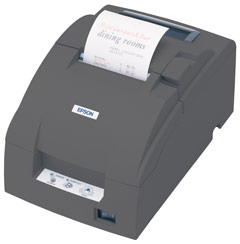Epson TM-U220

Impact Dot Matrix Printers
Highly Reliable Impact POS Printer
Impact Dot Matrix Printers |
||||||
| PRINTER | ||||||
|---|---|---|---|---|---|---|
| PRINT METHOD | 9-pin, serial impact dot matrix | |||||
| PRINT FONT | 7 x 9 / 9 x 9 | |||||
| COLUMN CAPACITY | 40 or 42 columns / 33 or 35 columns | |||||
| CHARACTER SIZE | 1.2(W) x 3.1 (H) mm / 1.6 (W) x 3.1 (H) mm | |||||
| CHARACTER SET | 95 Alphanumeric characters, 37 International characters, 128 x 12 Graphic characters Traditional / Simplified Chinese, Thai, Japanese, Korean |
|||||
| PRINT SPEED | Approx. 4.7 LPS (40 columns, 16CPI) / Approx. 6 LPS (30 columns, 16 CPI) | |||||
| DATA BUFFER | 4 KB or 40 bytes | |||||
| INTERFACE | RS-232C, Bi-directional parallel, Dealer Option: USB, 10 Base-T | |||||
| PAPER DIMENSIONS | 57.5 + 0.5, 69.5 + 0.5, 76mm 0.5mm x dia. 83.0mm (roll) | |||||
| PAPER THICKNESS | 0.06 to 0.085mm | |||||
| COPY CAPABILITY | One original and one copy | |||||
| INKED RIBBON | ERC-38 (black, black and red) | |||||
| RIBBON LIFE | Black: 3 x 106 characters B/R: 15 x 105 characters (black) 75 x 104 characters (red) |
|||||
| POWER SUPPLY | AC adapter (included) | |||||
| POWER CONSUMPTION | Approx. 31 W average | |||||
| D.K.D. FUNCTION | 2 drivers | |||||
| RELIABILITY | ||||||
| MTBF | 18 x 104 hours | |||||
| MCBF | 18 x 106 lines | |||||
| EMI STANDARDS | VCCI class A, FCC class A, CE marking, AS / NZS 3548 class B | |||||
| SAFETY STANDARDS | UL, CSA, TV (EN60950) | |||||
| PRODUCT OPTIONS | ||||||
| FACTORY OPTION | Paper near-end sensor | |||||
| PS-180 | Power Supply | |||||
| RIBBON CASETTE | (Purple, Black, Black and Red) | |||||
| WH10 | Wall Hanging Bracket | |||||
| OVERALL DIMENSIONS | A Type: 160mm (W) x 286mm (D) x 157.5mm (H) (Approx. 2.7Kg) B Type: 160mm (W) x 248mm (D) x 138.5mm (H) (Approx. 2.5Kg) C Type: 160mm (W) x 248mm (D) x 138.5mm (H) (Approx. 2.3Kg) |
|||||
Usage Conditions
Epson products are designed and made to give highly reliable use
and long life when used according to its specifications. With any system, product
or device used in situations where human life may be involved or at risk,
Epson advises that you should take all necessary steps to ensure the suitability
of your Epson product for inclusion in your system, and recommends that you
include fail-safe procedures and redundancy support or backup equipment in your system,
to maintain the maximum safety margin and optimum system reliability.

